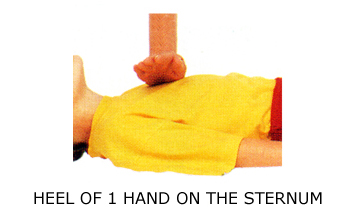Child Compressions
PERFORMING CPR
Studies have shown that survival rate improved significantly whenever bystanders attempted to provide CPR, with emphasis on blood flow and not solely on the exact sequences of compressions and rescue breaths. In other words, rather than not attempt CPR due to fear of doing it incorrectly, it is more important to remember to push vigorous (i.e. hard and fast) than to remember exactly how many times to push.
Before commencing CPR first determine if the victim has a pulse. As with an adult victim, a child’s pulse is checked at the carotid artery by placing two fingertips and applying slight pressure for no more than 10 seconds. At the same time observe the victim’s chest and face for signs of normal breathing. If no pulse is detected or you are not sure, it’s best to immediately begin chest compressions.
“C” is for COMPRESSIONS
When performing chest compressions on a child proper hand placement  is the same as with adults. Place the heel of your dominant hand on the sternum, in the center of the chest on the nipple line. Depending on a child victim’s size, only one hand may be used for compressions of about about 2 inches or one-third (1/3) chest depth, at a brisk rate of 100 to 120 compressions per minute (that’s nearly 2 compressions per second). It’s critical to remember to avoid leaning on the victim’s chest between compressions to allow full recoil of his thoracic cavity – you should be able to swipe a credit card between your hands and the victim chest after each compression. If you feel or hear a slight cracking sound, do not become alarmed and do not stop your efforts! Many rescuers fail to compress sufficiently deeply for fear of further injuring the victim but damaged cartilage or cracked ribs are far less serious than a lost life.
is the same as with adults. Place the heel of your dominant hand on the sternum, in the center of the chest on the nipple line. Depending on a child victim’s size, only one hand may be used for compressions of about about 2 inches or one-third (1/3) chest depth, at a brisk rate of 100 to 120 compressions per minute (that’s nearly 2 compressions per second). It’s critical to remember to avoid leaning on the victim’s chest between compressions to allow full recoil of his thoracic cavity – you should be able to swipe a credit card between your hands and the victim chest after each compression. If you feel or hear a slight cracking sound, do not become alarmed and do not stop your efforts! Many rescuers fail to compress sufficiently deeply for fear of further injuring the victim but damaged cartilage or cracked ribs are far less serious than a lost life.